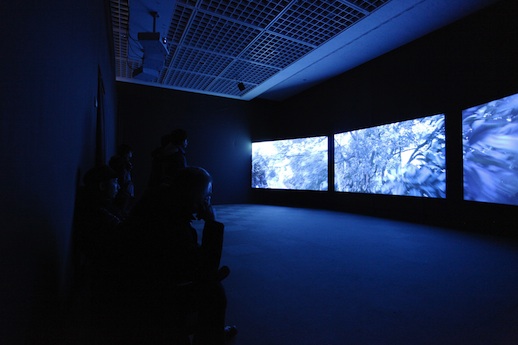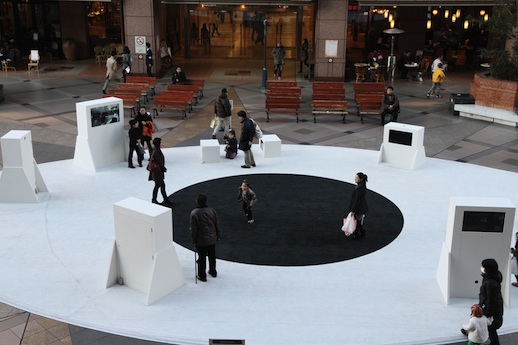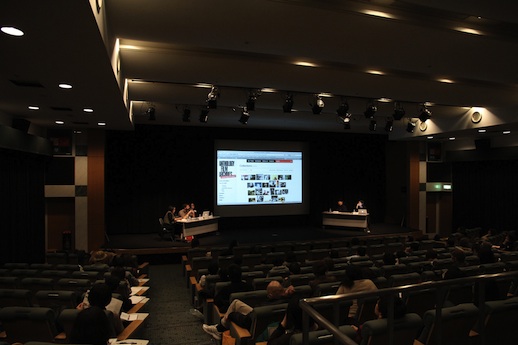The Physical, the Material and the Moving Image
Straddling contemporary visual art exhibition, mini film festival and symposium venue, the Yebisu International Festival for Art & Alternative Visions has now become a firm fixture in Tokyo’s winter arts calendar, with tightly curated programs and a firm and palpable devotion to exploring thematic issues with depth and rigor.
A collaborative project between the Tokyo Metropolitan Museum of Photography and the Tokyo Culture Creation Project, the “Yebizo” festival returned for its fourth installment this year from February 10–26. As the title “How Physical” suggests, the focus this year was on works that highlighted the “materiality” and “corporeality” of the moving image. As curator Keiko Okumura points out in her introduction to the catalog, “materiality” can be understood both in terms of the physical equipment, devices, props that facilitate the creation of film and video, as well as the physical layout and dimensions of the space in which these images are shown and exhibited, and the infrastructure through which it is disseminated.

In several cases, the mechanisms that embody this “physicality” were singled out and put on display, inviting viewers to scrutinize the processes by which images are actually fabricated. Ryusuke Ito’s Film Studies: Odessa’s Steps was a candid revelation of how the magician’s tools of the trade are deployed, so to speak. A tiny model of a baby carriage gets dragged along a rotating dais of “steps” that consist merely of makeshift protuberances placed at regular intervals along its circumference. At the same time, an onscreen projection on the wall just in front of this setup shows us how these physical props get translated into a moving image. Although the carriage seems to clatter down the steps in a perpetual descent, this is an illusion that Ito has created just by tilting the brick walls in the background to give viewers misleading visual cues regarding the direction of the carriage’s movement.
Exploiting a similar gap in how still objects and moving images relate to (or clash) with each other, Korean artist Yeondoo Jung’s Six Points is an enthusiastic attempt to close the gap between the two. Jung takes streetscape photos of six immigrant districts in New York and reassembles them on a three-dimensional set, where the physical limitations of a static image are enhanced (often comically exaggerated) by strategically placed lighting, perfectly formed shadows, and careful color correction. Filmed by a camera that pans laterally in a slow graze, the result is a digital, high-definition version of a revolving lantern that recalls Indian artist Sheba Chhachhi’s digital “fish lamps”. On the one hand, Jung’s work seems to be a technically accomplished, media-straddling digital collage. By the same token, however, perhaps it’s just a clumsy, overwrought translation of still images into moving ones that tries to enthusiastically overcompensate for the deficiencies in its source footage.

Hanging Garden, a 15-minute short that Jung also screened as part of “Deep Structure”, a film series showcasing the work of younger contemporary Korean artists, explored similar themes with a completely different approach. Whereas Six Points exploits the uncanny sensations that result from imperfectly resolved aesthetic issues that arise when still images are translated into moving ones, Hanging Garden meticulously erases all traces of its own fabrication, creating a perfectly sutured illusion that doubly confounds the viewer with the virtuoso techniques by which it was made. In brief: the work appears to be a single long take filmed by a camera that pans laterally across a foreshortened (but seemingly endless) stage with a heavy velvet curtain, slowly peeled back by a black-suited narrator who regales us with the story of how a Korean royal from the Joseon Dynasty and his Turkish wife built a massive “hanging garden” that surpassed even the mythic gardens at Babylon in size and grandeur. The lush landscape that slowly unfolds behind the curtain is filmed live, but in fact the entire stage and curtain-drawing sequence was created using a “stop trick” (stopping filming, changing the set, and then resuming filming), first pioneered by the nineteenth century French filmmaker, magician and illusionist George Méliès. The making-of video outside the theater that greeted visitors upon their exit revealed that the stage was continually being dismantled on the left end while also being extended on the right end as the camera continued to pan across it, creating the illusion of the garden’s endless plenitude, and the seductive sweep of the narrative’s grandeur.

“Rectangular Prism”, a suite of four short films selected by musician and filmmaker Jim O’Rourke, was another highlight of Yebizo’s compact but thoughtfully assembled film program. Walter de Maria’s 29-minute film Hard Core was a luxuriant, sensuous attempt to capture a perspective-less state of extreme flatness — the camera seems to rotate frictionless around itself, performing seven 360-degree pans (that could pass for a continuous horizontal tracking sequence) across the arid landscape of the Black Rock desert in Nevada, while the radiance of the ambient light gradually dwindles, from high noon to deep dusk.
It was followed by Beverly Grant and Tony Conrad’s minimalist tour-de-force of animated op-art, Straight and Narrow. This 10-minute sequence consists exclusively of horizontal and vertical black and white lines and stripes, varied for thickness and density, cross-hatched and overlaid onto each other in a frenetic boogie, perfectly matched to the hustling saunter of John Cale and Terry Riley’s piano-led piece, Ides of March. Like a hyperactive test pattern, the film took advantage of retinal afterimages and the stroboscopic effect to transcend its status as a two-dimensional projection, inducing optical and physiological responses in the viewer. As virtual images continue to flit across the screens of one of the many digital devices and formats that surround us — and as we swipe endlessly and weightlessly at an endless stream of images on our smartphones and iPads that barely register as physical entities — this film, like many of the other works on display, was a compelling demonstration of the potential density and force that the moving image can exert on our minds and senses.
Darryl Jingwen Wee
Born and raised in Singapore, Darryl graduated from Harvard College in 2006 with a BA in French, and currently works as a writer, translator and interpreter based in Tokyo. He edits and translates TAB event listings and writes about art, architecture and food for WSJ, Art Asia Pacific, Artforum.com, Bauwelt, Paper Sky and Singapore Architect. See other writings
Tokyo Culture Creation Project
Tokyo Culture Creation Project



